In the world of summer entertaining, there’s a secret weapon that can instantly transform your gathering from ordinary to extraordinary: the art of seasonal cocktail pairing. When thoughtfully matched with your menu, the right cocktail doesn’t just quench thirst—it enhances flavors, creates memorable experiences, and showcases your attention to detail as a host.
Whether you’re planning an intimate dinner, a backyard BBQ, or an elegant soirée, understanding how to pair cocktails with your summer menu will elevate the entire experience for your guests. This comprehensive guide will walk you through the science of cocktail pairing, provide perfect matches for popular summer dishes, and help you create a cohesive drink menu that will have everyone talking about your hosting skills.
The Science and Art of Cocktail Pairing
Test Your Cocktail Pairing Knowledge
The magic of a perfect pairing happens when your cocktail and food come together to create a taste experience greater than the sum of its parts. There are two primary approaches to successful pairings:
Complementary pairings involve similar flavor profiles that enhance each other, like an herbaceous gin cocktail paired with a dish featuring the same herbs.
Contrasting pairings create balance by offsetting opposite characteristics, such as a spicy dish with a sweet, cooling cocktail.
| Principle | Description | Example Pairing |
|---|---|---|
| Intensity Matching | Match the weight and power of the drink with the food | Spirit-forward Old Fashioned with grilled ribeye steak |
| Acidity Balance | Use acidic drinks to cut through fatty, rich foods | Whiskey Sour with fried chicken |
| Sweetness Balance | Pair sweet cocktails with salty or spicy foods | Frozen Piña Colada with spicy grilled shrimp |
| Regional Connections | Match drinks and foods from the same region | Paloma cocktail with fish tacos |
| Seasonal Synchronicity | Use ingredients that peak at the same time | Strawberry basil smash with summer caprese salad |
Key Elements of Successful Pairings
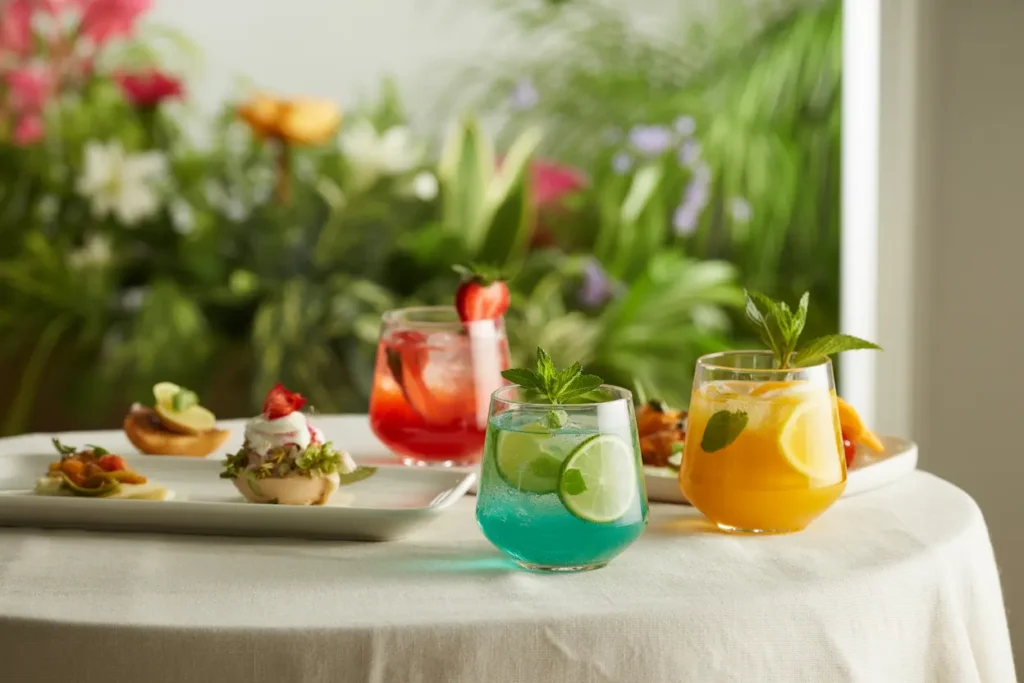
When building your pairings, consider these critical elements:
Weight and intensity refer to how light or heavy both the cocktail and dish feel. A delicate seafood crudo would be overwhelmed by a strong, bourbon-heavy cocktail, while a light spritz might disappear against a rich, smoky brisket.
Acidity is your secret weapon for cutting through richness or fat. Just as a squeeze of lemon brightens up fish, an acidic cocktail can refresh your palate between bites of richer dishes.
Sweetness in cocktails needs careful consideration. While sweet drinks can beautifully balance spicy or salty foods, they can make sweet dishes cloying. The golden rule: your drink should generally be at least as sweet as your food, especially with desserts.
Alcohol content affects how we perceive flavors. Higher ABV cocktails intensify spicy heat and can overwhelm subtle flavors, while lower-alcohol options are more versatile with lighter summer fare.
Carbonation acts as a palate cleanser, making effervescent drinks excellent choices for rich or fried foods.
Common Pairing Mistakes to Avoid
What’s your favorite vegetable to feature in both summer dishes and cocktails?
| Common Mistake | Why It Happens | How to Fix It |
|---|---|---|
| Pairing bitter with bitter | Compounds amplify each other | Balance bitterness with sweetness or richness |
| High-proof drinks with spicy food | Sugar in food makes the drink taste sour | Choose lower-ABV options with some sweetness |
| Dry cocktails with sweet desserts | Intense flavors overwhelm subtle ones | Ensure your cocktail is at least as sweet as your dessert |
| Delicate drinks with bold foods | Strong flavors overwhelm subtle ones | Match intensity levels |
| Too many competing flavors | Complex cocktail + complex dish = confusion | Keep one element simpler to let the other shine |
Essential Summer Cocktail Categories and Their Ideal Food Companions
Bright Citrus-Forward Cocktails
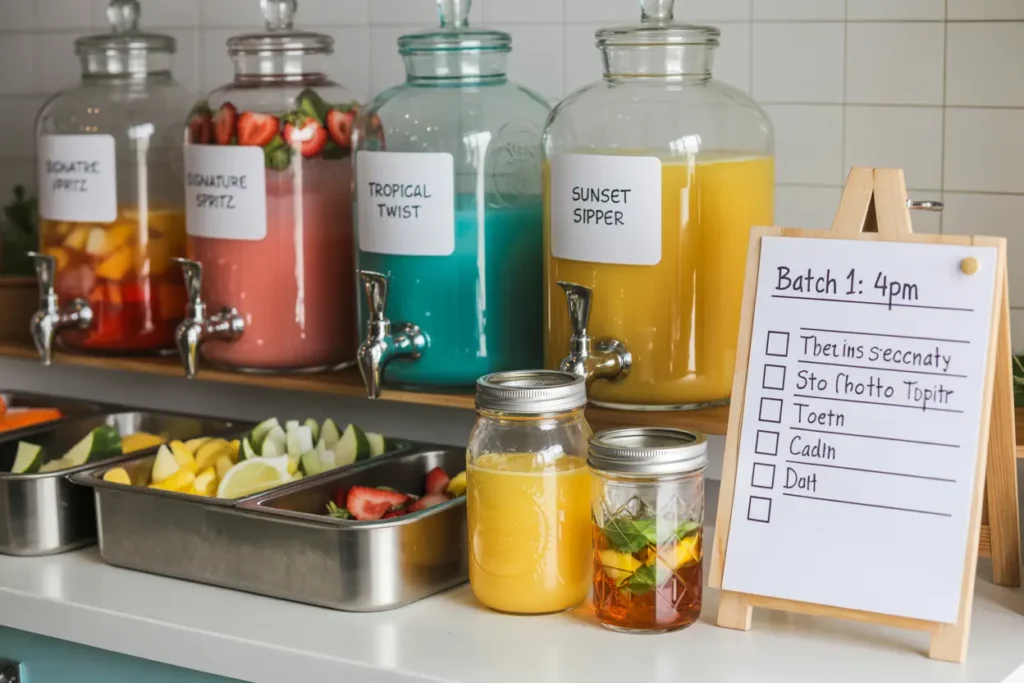
Citrus cocktails are summer classics that pair beautifully with many warm-weather dishes. They feature lemons, limes, grapefruits, or oranges as the star ingredients.
Classic examples include:
- Margarita: Tequila, lime juice, orange liqueur
- Daiquiri: White rum, lime juice, simple syrup
- Paloma: Tequila, grapefruit soda, lime
- Tom Collins: Gin, lemon juice, simple syrup, soda
Citrus-forward cocktails work wonderfully with seafood, light salads, and grilled chicken. The acidity cuts through rich dishes like fish tacos or buttery scallops while enhancing the natural flavors of the sea.
Herb-Infused Garden Cocktails
As garden herbs reach their aromatic peak in summer, they become natural stars in seasonal cocktails that work beautifully with summer fare.
Classic examples include:
- Mojito: White rum, mint, lime, sugar, soda
- Basil Smash: Gin, basil, lemon juice, simple syrup
- Rosemary Gin Fizz: Gin, rosemary syrup, lemon, egg white, soda
- Thyme for a Gimlet: Gin, lime juice, thyme-infused simple syrup
Herb-infused cocktails pair naturally with dishes that incorporate similar herbs – Mediterranean cuisines, vegetable-forward dishes, herb-roasted proteins, and garden-fresh salads.
Fruit-Forward Summer Punches and Sangrias
Classic examples include:
- Classic Red Sangria: Red wine, brandy, orange, lemon, seasonal fruits
- White Peach Sangria: White wine, peach liqueur, fresh peaches, berries
- Pimm’s Cup: Pimm’s No. 1, lemonade, cucumber, fruits, mint
- Watermelon Punch: Vodka, watermelon juice, lime, mint
These fruit-forward beverages shine alongside charcuterie and cheese boards, where their fruity notes complement cured meats and contrast with creamy cheeses. They also pair wonderfully with grilled fruits and light salads.
Refreshing Spritzers and Fizzes
Effervescent cocktails are summer entertaining MVPs – low in alcohol, high in refreshment, and perfect for extended gatherings in warm weather.
Classic examples include:
- Aperol Spritz: Aperol, prosecco, soda water
- Hugo Spritz: Elderflower liqueur, prosecco, mint, lime, soda
- French 75: Gin, lemon juice, simple syrup, champagne
- Gin Fizz: Gin, lemon juice, sugar, egg white, soda water
Spritzers and fizzes pair brilliantly with light appetizers, making them perfect for the start of a summer gathering. Their bubbles and often bitter-sweet profiles stimulate the appetite and refresh the palate.
Spirit-Forward Summer Sippers
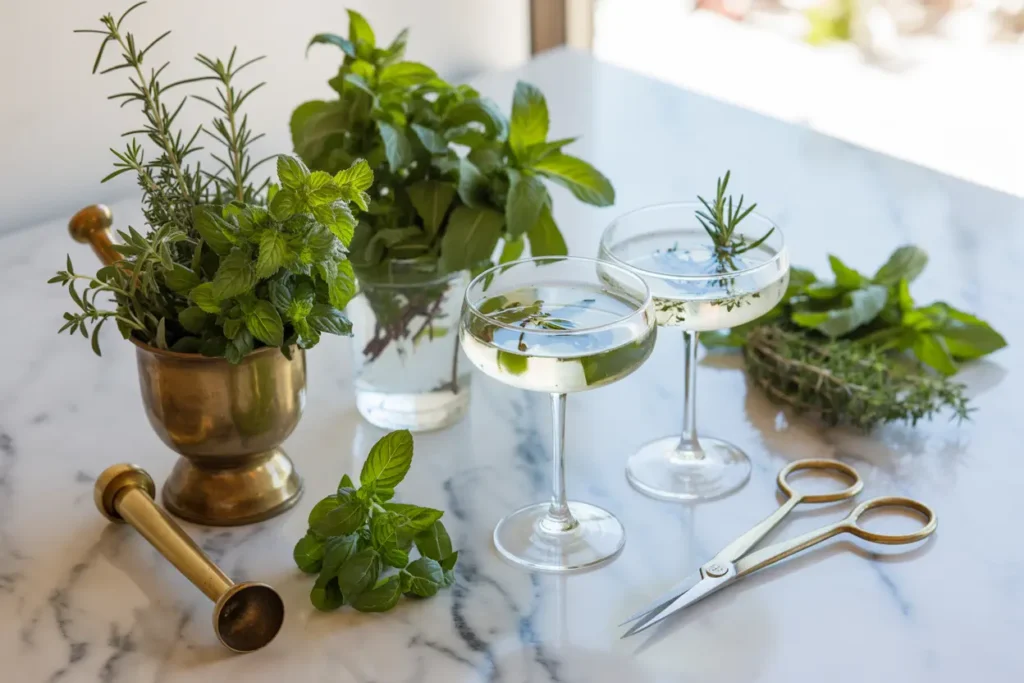
Not all summer cocktails need to be light and fruity. Spirit-forward options showcase premium liquors with minimal mixers, creating sophisticated sipping experiences.
Classic examples include:
- White Negroni: Gin, Lillet Blanc, Suze or other gentian liqueur
- Bourbon Smash: Bourbon, fresh fruit (often berries), herbs, lemon
- Summer Old Fashioned: Bourbon or rye, fruit-infused simple syrup, bitters
- Mezcal Negroni: Mezcal, sweet vermouth, Campari
These robust cocktails shine alongside grilled red meats, particularly those with a bit of char or smoke. Aged cheeses and smoked or barbecued dishes with complex spice rubs find natural friends in these sophisticated drinks.
Perfect Pairings for Popular Summer Dishes
Cocktail Matches for Grilled Meats and BBQ
| Meat Type | Flavor Profile | Ideal Cocktail Pairings | Why It Works |
|---|---|---|---|
| Ribeye/Brisket | Rich, fatty, intense | Old Fashioned, Manhattan, Boulevardier | Strong spirits stand up to richness; bitters cut through fat |
| Leaner Beef | Mild, elegant | Whiskey Smash, Kentucky Mule | Fruit and ginger complement without overwhelming |
| Pork Ribs/Shoulder | Sweet, often glazed | Bourbon Peach Smash, Dark & Stormy | Fruit and spice elements mirror barbecue flavors |
| Pork Chops | Mild, slightly sweet | Apple Highball, Spiced Rum Punch | Traditional flavor pairings in cocktail form |
| Chicken Breast | Mild, lean | Cucumber Collins, Gin & Tonic with herbs | Refreshing contrast to grilled flavors |
| Chicken Thighs | Richer, more flavor | Paloma, Mezcal Margarita | Citrus cuts richness; smoke complements darker meat |
| Lamb | Gamey, herbaceous | Rosemary Gin Fizz, Negroni | Herbal notes complement traditional lamb seasonings |
| Sausages | Spiced, fatty | Michelada, Aperol Spritz | Bubbles and acidity cut through fat and spice |
Summer Seafood and Cocktail Harmony
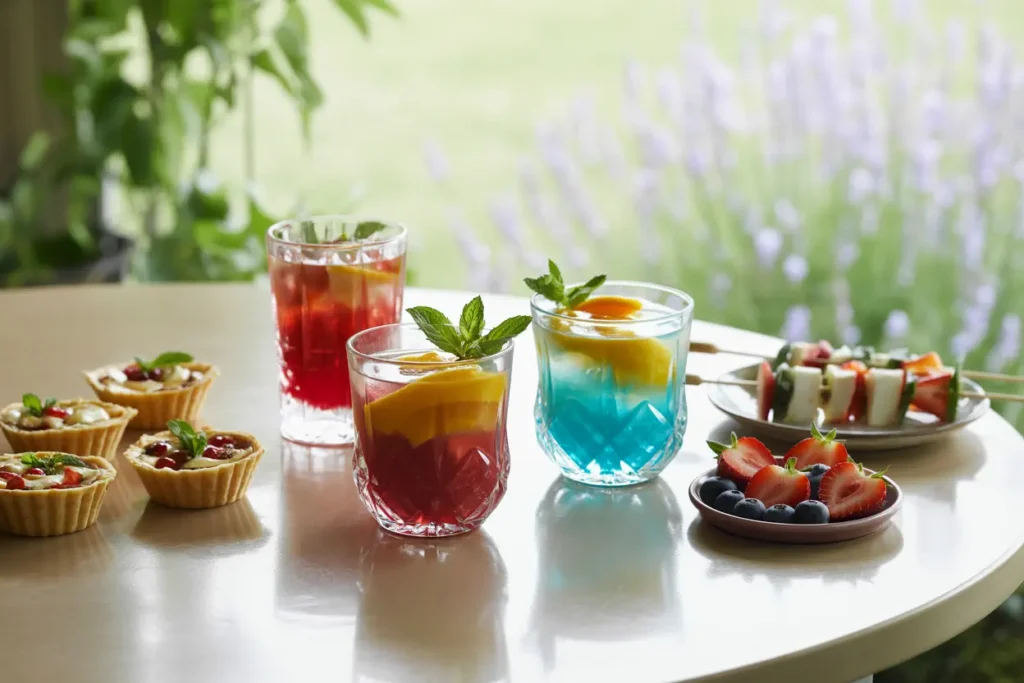
For raw bar items like oysters, shrimp cocktail, or ceviche, bright, mineral-driven cocktails create magical combinations. A classic Martini highlights oysters’ brininess, while a Daiquiri’s clean lime profile complements ceviche’s citrus notes.
With grilled or roasted fish, consider the preparation method and seasoning. A simply prepared white fish might call for a Cucumber Collins, while a herb-crusted fish works beautifully with an herbal gin cocktail. Richer fish like salmon can stand up to more complex options like a Blood Orange Margarita.
For spiced seafood dishes like blackened fish or cajun shrimp, look to cocktails with enough sweetness to balance the heat, such as a Hurricane (rum, passion fruit, citrus) or Frozen Daiquiri.
Farm-to-Table Vegetarian Pairings
Fresh vegetable plates and crudités shine alongside bright, herbal cocktails like a Cucumber Vodka Collins or Basil Gimlet. For dips like hummus or baba ganoush, consider a Gin & Tonic with rosemary to complement Mediterranean flavors.
Summer salads find natural friends in citrus-forward cocktails. A classic Tom Collins adds brightness to a watermelon-feta salad, while a White Wine Sangria with peaches complements a stone fruit and burrata combination.
Heartier vegetarian options like grilled portobello mushrooms or plant-based burgers can stand up to more robust cocktails, such as a smoky Mezcal Paloma or a Bourbon Smash with berries.
Sweet Finishes: Desserts and Their Cocktail Companions
| Dessert Type | Flavor Notes | Perfect Cocktail Match | Pairing Principles |
|---|---|---|---|
| Berry Tart/Pavlova | Sweet-tart, fresh berry | Strawberry Daiquiri, Bramble | Complementary fruit flavors; balanced sweetness |
| Peach Cobbler/Crisp | Sweet, warm spices | Bourbon Peach Smash, Peach Bellini | Stone fruit harmony; bourbon complements baking spices |
| Lemon Bars/Tart | Bright, citrusy | Limoncello Spritz, French 75 | Citrus complementarity; effervescence balances richness |
| Chocolate Mousse | Rich, creamy | Espresso Martini, Brandy Alexander | Coffee notes enhance chocolate; creamy textures align |
| Vanilla Panna Cotta | Smooth, delicate | White Russian, Vanilla Bean Old Fashioned | Complementary vanilla notes; textural harmony |
| Angel Food Cake | Light, airy | Elderflower Champagne Cocktail | Delicate flavors; light effervescence matches texture |
| Ice Cream/Gelato | Creamy, cold | White Russian, Mudslide, Blended Daiquiri | Texture contrast; temperature alignment; flavor match |
| Fruit Sorbet | Intensely fruity | Champagne cocktails, Frozen Fruit Daiquiris | Temperature alignment; complementary fruit profiles |
Creating a Cohesive Cocktail Menu for Summer Entertaining
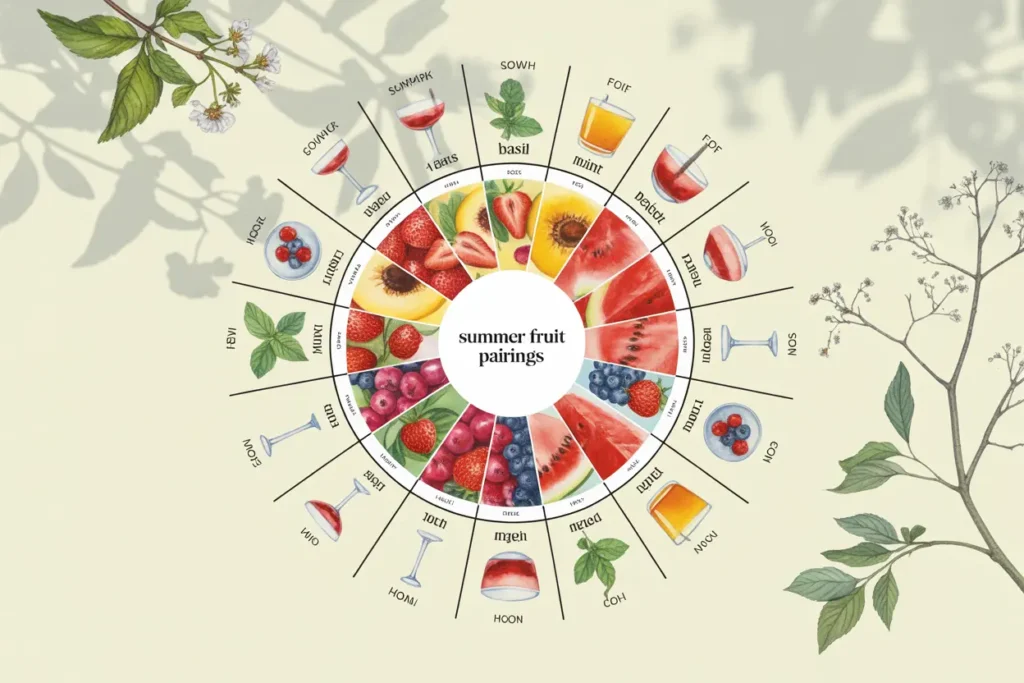
Planning Your Event Menu from Start to Finish
Setting the theme and mood begins with welcoming drinks that are light, refreshing, and not too high in alcohol. For dinner pairings, select cocktails that complement your food menu. After-dinner or dessert cocktails can be sweeter, more indulgent, or higher in alcohol.
The number of cocktail options should scale with your guest count. For intimate gatherings (4-8 guests), 2-3 well-chosen options create a curated experience. For larger parties (15+ guests), 4-5 options provide variety while remaining manageable.
Balancing variety with cohesion is crucial—your selections should offer something for different preferences while maintaining a unified theme or concept.
Batch Preparation Techniques for Stress-Free Hosting
For batch preparation, these cocktails work particularly well:
- Sangrias and punches (can be made 24 hours ahead, adding carbonated elements just before serving)
- Negronis and Boulevardiers (can be batched weeks ahead and stored in the freezer)
- Margaritas and Daiquiris (mix everything except ice 24 hours ahead)
- Spritzers (prepare the base 24 hours ahead, add bubbles when serving)
When scaling recipes, remember:
- Spirits, liqueurs, and most mixers can be scaled directly
- Reduce citrus juices by about 10% when batching
- Reduce sweeteners by about 10-15% when batching
- Add bitters carefully—they become more pronounced over time
Adding finishing touches just before serving makes batched cocktails feel fresh and special:
- Fresh garnishes prepared shortly before guests arrive
- Rimming glasses to order
- Adding the carbonated element tableside
- Offering a garnish station where guests can customize their drinks
Creating a Self-Service Cocktail Station
Essential components for a DIY cocktail bar include:
- Pre-batched cocktail bases in clearly labeled pitchers or dispensers
- Appropriate glassware (pre-chill if possible)
- Ice in an insulated container with a scoop
- Garnishes in small bowls with serving utensils
- Carbonated mixers kept chilled until needed
- Printed recipe cards or a small sign with mixing instructions
For guest-friendly navigation, organize ingredients in the order they’ll be used. Use height variations to create visual interest and improve accessibility.
Seasonal Ingredients Spotlight for Summer Cocktails
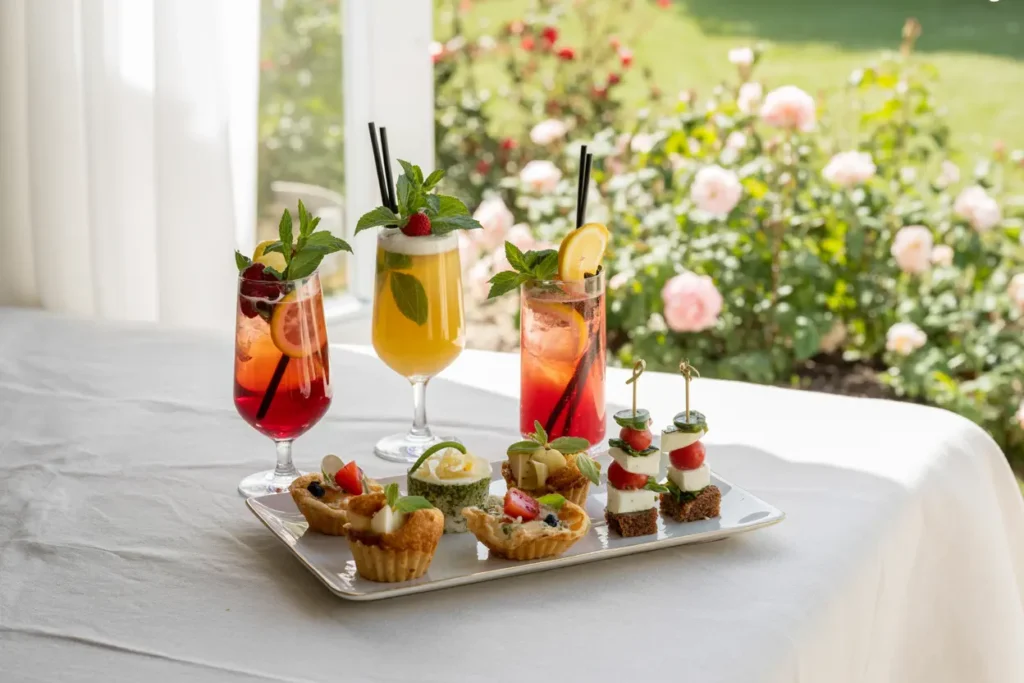
Peak-Season Fruits and Their Cocktail Applications
| Ingredient | Peak Season | Flavor Profile | Best Cocktail Applications | Complementary Foods |
|---|---|---|---|---|
| Strawberries | May-June | Sweet, slightly tart | Daiquiris, Smashes, Infused Vodka | Salads, Chicken, Cheese |
| Blueberries | June-August | Mildly sweet | Collins, Mojitos, Infused Gin | Lemon dishes, Pork |
| Peaches | July-August | Sweet, floral | Bellinis, Bourbon cocktails, Sangria | Grilled meats, Burrata |
| Watermelon | July-August | Refreshing, subtly sweet | Margaritas, Mojitos, Coolers | Feta cheese dishes, Light salads |
| Blackberries | July-August | Sweet-tart, complex | Bramble, Mojitos, Whiskey drinks | Game, Duck, Dark chocolate |
| Raspberries | July-August | Bright, tart | Smashes, Collins, Fizzes | Chocolate, Vanilla, Seafood |
| Cherries | June-July | Deep, sweet | Manhattans, Old Fashioneds, Sours | Duck, Pork, Dark chocolate |
| Pineapple | Year-round (peak summer) | Sweet-tart, tropical | Tiki drinks, Infused rum | Ham, Seafood, Spicy dishes |
| Mango | June-August | Sweet, floral | Daiquiris, Margaritas, Sangria | Spicy dishes, Seafood, Poultry |
Garden-Fresh Herbs for Aromatic Summer Drinks
Essential summer herbs bring distinctive personalities to your drinks:
Mint is the most versatile cocktail herb, working in mojitos, juleps, and countless variations. For best results, gently muddle to release essential oils without bitterness.
Basil adds complex anise and pepper notes that pair beautifully with gin, vodka, and light rums. Basil bruises easily, so clap leaves between hands or muddle very gently.
Rosemary contributes piney, resinous notes that stand up to aged spirits like whiskey and aged rum. Its sturdy stems make excellent garnishes or can be set briefly aflame for aromatic smoke.
Thyme offers subtle herbal notes with slight minty qualities that complement gin, vodka, and light aged spirits. Lemon thyme varieties add citrus notes that brighten cocktails naturally.
Lavender brings distinctive floral notes that pair wonderfully with gin, vodka, and sparkling wines. Use sparingly to avoid a soapy quality—a little goes a long way.
Extraction methods significantly impact herb flavor in cocktails:
- Muddling: Best for tender herbs; gently press to release oils without tearing
- Infusion: Submerge herbs in spirits for 1-24 hours, depending on desired flavor
- Syrups: Simmer herbs in simple syrup, then strain for easy-to-use flavored sweeteners
- Garnishes: Use sprigs, individual leaves, or herb-infused ice for aromatic appeal
Unexpected Summer Ingredients for Creative Cocktails
Beyond the obvious fruits and herbs, summer offers unique ingredients that can transform ordinary cocktails:
Vegetables might seem unlikely cocktail ingredients, but their fresh flavors can create sophisticated drinks:
- Cucumber adds cooling, subtle sweetness that pairs beautifully with gin, vodka, and tequila
- Bell peppers bring sweet, slightly grassy notes that create unique cocktails
- Tomatoes shine beyond just Bloody Marys – cherry tomatoes can be muddled for subtle umami
- Carrots offer natural sweetness and vibrant color that mixes well with ginger and citrus
Spices take on new life in summer applications:
- Ginger adds heat and complexity to fruit-forward drinks
- Cardamom brings aromatic complexity that enhances stone fruits and berries
- Pink peppercorns offer gentle heat and subtle fruity notes that complement berries and citrus
- Chile peppers create controlled heat that balances sweet summer fruits
Florals provide delicate aromatics that elevate summer cocktails:
- Elderflower brings honey-like floral notes that enhance sparkling wine, gin, and vodka cocktails
- Rose adds delicate floral notes to drinks with berries or stone fruits
- Hibiscus contributes vibrant color and tart-berry flavor
Inclusive Summer Entertaining: Beyond Alcoholic Cocktails
Cocktail Pairing Troubleshooter
What’s the main issue with your cocktail pairing?
Sophisticated Mocktails That Stand Up to Food Pairings
| Mocktail Style | Key Ingredients | Food Pairing Suggestions | Pairing Principles |
|---|---|---|---|
| Garden Refresher | Cucumber, mint, lime, soda | Light salads, crudités, mild cheeses | Complementary fresh flavors; light intensity match |
| Citrus Spritz | Grapefruit juice, rosemary syrup, tonic | Seafood, light pasta, Mediterranean dishes | Acidity cuts richness; herb notes complement food |
| Berry Shrub Fizz | Berry shrub, honey, soda water | Charcuterie, aged cheeses, and chocolate desserts | Fruity-acid balance; sweet-tart contrast with food |
| Spiced Apple Sparkler | Apple cider, cinnamon, star anise, soda | Roasted vegetables, autumn squash dishes | Complementary spice profiles; warming notes |
| Herbal Iced Tea Cooler | Cold-brew tea, herb syrup, lemon | Complementary spice profiles, warming notes | Tannin structure mirrors wine; herbal bridges |
| Smoke & Spice | Smoked tea, ginger beer, lime | BBQ dishes, grilled meats, spicy foods | Smoke complements grill flavors; spice balances heat |
Low-ABV Options for Extended Entertaining
For summer gatherings that stretch from afternoon into evening, low-alcohol cocktails offer the perfect balance—enough spirit to satisfy without the heavy impact of full-proof drinks.
Spritz variations represent the classic approach to low-ABV drinking:
- The traditional Aperol Spritz (Aperol, prosecco, soda) offers a bitter-sweet balance
- A Hugo Spritz (elderflower liqueur, prosecco, mint) provides floral elegance
- A Lillet Spritz (Lillet Blanc, soda, citrus) brings subtle complexity
- A Cynar Spritz (Cynar, prosecco, soda) offers sophisticated bitterness
Fortified wine-based options create sophisticated, low-proof cocktails:
- Sherry cocktails like the Bamboo (dry sherry, dry vermouth, bitters) offer nutty complexity
- Vermouth-based drinks like the Americano (Campari, sweet vermouth, soda) provide a bitter-sweet balance
- Port tonics (white port, tonic, citrus) deliver refreshing sophistication
Accommodating Dietary Preferences and Restrictions

| Dietary Restriction | Ingredients to Avoid | Recommended Alternatives | Sample Cocktail Recipe |
|---|---|---|---|
| Dairy-Free | Cream, milk, butter-infused spirits | Some pre-made mixers, beer, and some bitters | Coconut Colada: Rum, coconut cream, pineapple juice, lime |
| Gluten-Free | Verified GF spirits, fresh juices, and homemade ingredients | Verified GF spirits, fresh juices, homemade ingredients | Paloma Pura: Tequila, fresh grapefruit, lime, agave, soda |
| Sugar-Free/Keto | Simple syrup, liqueurs, sweet mixers | Monk fruit syrup, erythritol, natural fruit essence | Keto Mule: Vodka, fresh lime, sugar-free ginger beer |
| Vegan | Egg white, honey, some wines | Aquafaba, agave or maple syrup, vegan-verified spirits | Aquafaba Whiskey Sour: Bourbon, lemon, aquafaba, maple syrup |
Expert Insights and Troubleshooting
Trending Summer Pairings for 2025
| Trend Name | Description | Key Ingredients | Ideal Food Pairing |
|---|---|---|---|
| Botanical Savory | Herbs and vegetables in savory-sweet balance | Respectively regional cuisines, seafood | Garden vegetable dishes, light proteins |
| Fermentation Forward | Incorporating house-fermented elements | Kombucha, kefir, fermented fruits | Cheese boards, fermented foods, pickles |
| Clarified Classics | Traditional cocktails made crystal clear | Milk-washed spirits, clarified juices | Elegant seafood, subtle flavors, raw bar |
| Global Citrus | Beyond lemon/lime to world citrus | Yuzu, calamansi, bergamot, finger lime | Respectively, regional cuisines, seafood |
| Tea-Forward | Complex tea infusions as cocktail bases | Specialty teas, tea syrups, tea-infused spirits | Asian cuisines, afternoon tea pairings |
Identifying and Fixing Common Pairing Problems
Quick fixes for common pairing disasters:
- Too boozy: Add club soda, tonic, or additional juice to dilute
- Too sweet: Add bitters, citrus juice, or tonic to balance
- Too bitter: Add simple syrup, fruit juice, or a dash of saline solution
- Too acidic: Add simple syrup, honey, or a sweeter liqueur
- Too bland: Add bitters, a spritz of citrus oil, or a pinch of salt
- Competing flavors: Simplify by removing either food or drink elements
Adjusting cocktails to better match food can be done easily with:
- Citrus wheel or wedge to add acidity
- Splash of soda to lighten intensity
- A dash of simple syrup to round harsh edges
- Extra ice to dilute slightly
- Fresh herb garnish to bridge the food flavors
- Aromatic bitters to add complexity
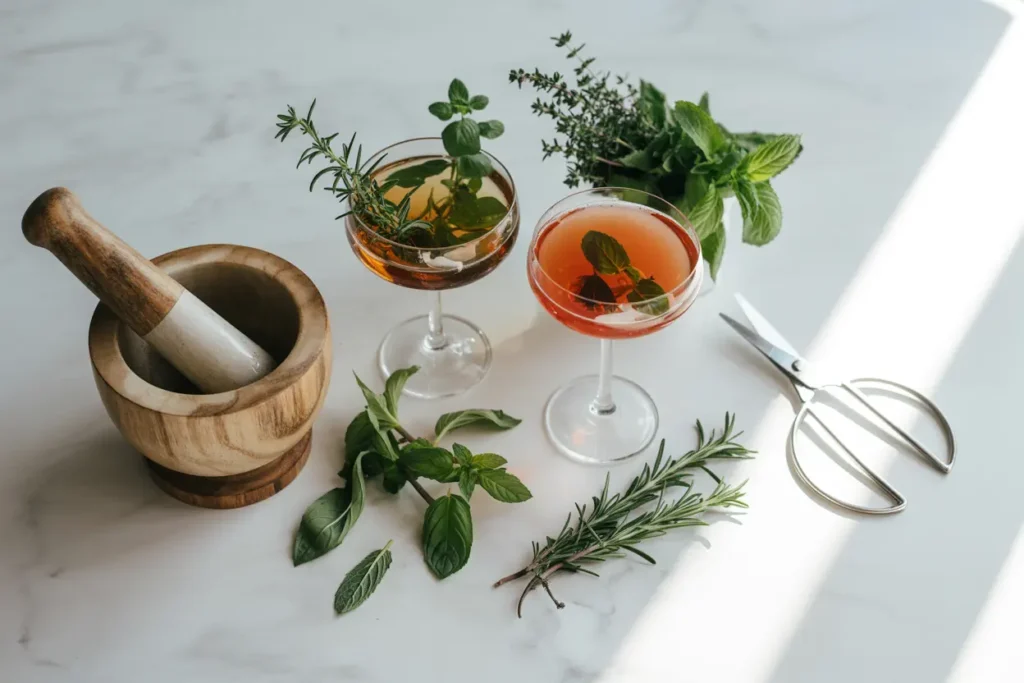
Conclusion
The art of seasonal cocktail pairing transforms summer entertaining from ordinary to extraordinary. Throughout this guide, we’ve explored how thoughtfully matched drinks can enhance your food, create memorable experiences, and showcase your skills as a host.
Key principles to ensure your summer cocktail pairings shine:
- Match intensity levels between your cocktails and cuisine
- Use acidity strategically to cut through rich dishes
- Balance sweetness carefully, especially with dessert pairings
- Consider temperature and texture as crucial elements
- Embrace seasonal ingredients at their peak for the most vibrant flavors
- Create inclusive options for all guests, regardless of dietary preferences
Remember that the best pairings often follow one of two approaches: complementary flavors that enhance similar notes or contrasting elements that balance each other. When executed thoughtfully, both strategies can create magical combinations.
As you develop your pairing style, don’t be afraid to experiment beyond conventional wisdom. Some of the most delightful discoveries happen when you take creative risks and trust your palate.
FAQ Section
What’s the single most versatile cocktail for summer food pairings?
A well-balanced Daiquiri is the champion. Its combination of rum, fresh lime juice, and simple syrup creates a bright, adaptable template that works with everything from seafood to grilled meats to fruit desserts. The acidity cuts through richness, the sweetness balances spice, and the rum provides just enough backbone without overwhelming delicate flavors.
How many different cocktails should I offer at my summer gathering?
For intimate dinners (4-8 guests), offer 2-3 well-chosen options. For medium parties (8-15 guests), provide 3-4 selections. For larger events (15+ guests), aim for 4-5 drinks spanning different styles. Quality always trumps quantity – executing a few options perfectly is better than offering numerous mediocre choices.
Can I pair cocktails with spicy foods, or will the alcohol amplify the heat too much?
You can pair cocktails with spicy foods, but avoid high-alcohol, spirit-forward cocktails as they indeed amplify heat. Instead, choose cocktails with moderate alcohol content and some sweetness, which helps tame spiciness. Classics like a Tommy’s Margarita (with agave syrup) or a Passion Fruit Mojito work beautifully with spicy dishes.
What’s the best way to accommodate guests who don’t drink alcohol?
Treat non-alcoholic options with the same care and creativity as alcoholic cocktails. Prepare sophisticated mocktails using fresh ingredients, complex syrups, and thoughtful presentations. Create custom non-alcoholic versions of your featured cocktails, offer at least one unique mocktail, use premium mixers and elegant garnishes, and serve mocktails in appropriate cocktail glassware.
What’s the ideal serving temperature for summer cocktails?
For most shaken, citrus-forward summer cocktails (daiquiris, margaritas), serve very cold at about 21-25°F. Spirit-forward stirred cocktails (negronis, manhattans) should be cold but not ice-cold, around 30-35°F. Highballs and spritzers should be quite cold at 33-38°F with plenty of ice – pre-chill glassware for optimal temperature maintenance.
Printable Recipe Card
Want just the essential recipe details without scrolling through the article? Get our printable recipe card with just the ingredients and instructions.

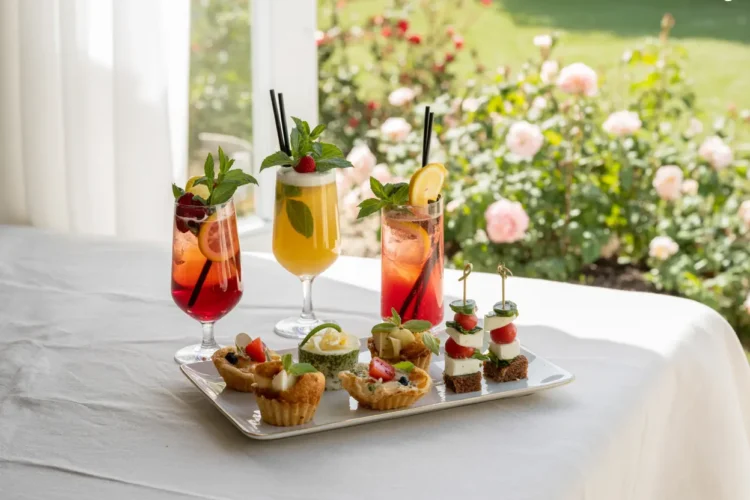
Pingback: Mocktail Mixology Basics: Fail Proof Art of Non-Alcoholic Drinks - Whaley Cooks
Pingback: Summer Drink Trends 2025: The Ultimate Guide That Will Transform Your Events - Whaley Cooks
Pingback: Tantalizing Summer Drinks: Creative Ice Cubes with a Twist - Whaley Cooks